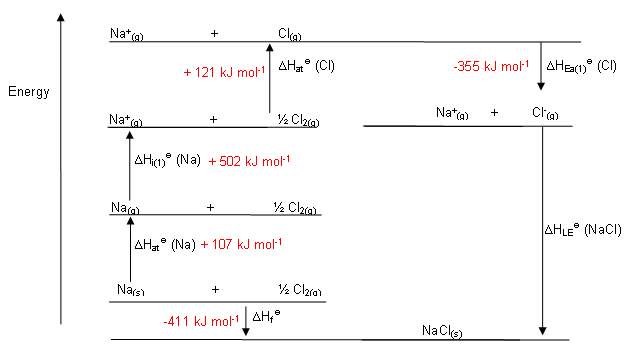

In such an arrangement each cation in the lattice is surrounded by more than one anion (typically four, six, or eight) and vice versa, so it is more stable than a system consisting of separate pairs of ions, in which there is only one cation–anion interaction in each pair. While Equation 8.1 has demonstrated that the formation of ion pairs from isolated ions releases large amounts of energy, even more energy is released when these ion pairs condense to form an ordered three-dimensional array ( Figure 7.8 "Definition of Ionic Radius"). These properties result from the regular arrangement of the ions in the crystalline lattice and from the strong electrostatic attractive forces between ions with opposite charges. They are not easily deformed, and they melt at relatively high temperatures. Ionic compounds are usually rigid, brittle, crystalline substances with flat surfaces that intersect at characteristic angles. Recall from Chapter 2 "Molecules, Ions, and Chemical Formulas" that the reaction of a metal with a nonmetal usually produces an ionic compound that is, electrons are transferred from the metal (the reductant) to the nonmetal (the oxidant). To use the Born–Haber cycle to calculate lattice energies.To understand the relationship between the lattice energy and physical properties of an ionic compound.
Sodium bromide lattice energy equation series#
A similar effect is seen when the anion becomes larger in a series of compounds with the same cation.Īrrange GaP, BaS, CaO, and RbCl in order of increasing lattice energy. Because r 0 in Equation 4.2.1 is the sum of the ionic radii of the cation and the anion ( r 0 = r + + r −), r 0 increases as the cation becomes larger in the series, so the magnitude of U decreases. This effect is illustrated in Figure 4.2.2, which shows that lattice energy decreases for the series LiX, NaX, and KX as the radius of X − increases.

For example, the calculated value of U for NaF is 910 kJ/mol, whereas U for MgO (containing Mg 2 + and O 2− ions) is 3795 kJ/mol.īecause lattice energy is inversely related to the internuclear distance, it is also inversely proportional to the size of the ions. Source: Data from CRC Handbook of Chemistry and Physics (2004).īecause the lattice energy depends on the product of the charges of the ions, a salt having a metal cation with a +2 charge (M 2 +) and a nonmetal anion with a −2 charge (X 2−) will have a lattice energy four times greater than one with M + and X −, assuming the ions are of comparable size (and have similar internuclear distances).

Energies of this magnitude can be decisive in determining the chemistry of the elements.

Representative values for calculated lattice energies, which range from about 600 to 10,000 kJ/mol, are listed in Table 4.2.1. The value of the constant k′ depends on the specific arrangement of ions in the solid lattice and their valence electron configurations, topics that will be discussed in more detail in the second semester. We see from Equation 4.4 that lattice energy is directly related to the product of the ion charges and inversely related to the internuclear distance. As before, Q 1 and Q 2 are the charges on the ions and r 0 is the internuclear distance. U, which is always a positive number, represents the amount of energy required to dissociate 1 mol of an ionic solid into the gaseous ions.


 0 kommentar(er)
0 kommentar(er)
